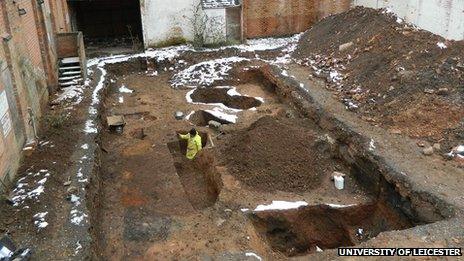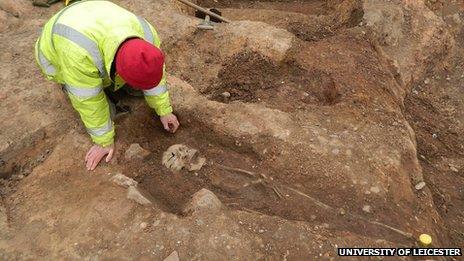Richard III team makes second Leicester car park find
- Published

The site of the excavation at Oxford Street

The bodies were found buried in a variety of positions, suggesting mixed religious beliefs among the dead

A jet ring with a mysterious symbol, thought to be early Christian, was among the finds

The site is earmarked for development
The team that discovered the remains of Richard III under a Leicester car park has made another find.
A 1,700-year-old Roman cemetery has been identified beneath another car park in the city.
Archaeologists from the University of Leicester believe the remains date back to AD300.
Researchers found 13 sets of remains of mixed age and sex as well as hairpins, belt buckles and other personal items at the site on Oxford Street.
In February remains found beneath Greyfriars car park were revealed to be those of the last Plantagenet monarch, Richard III.
Jet ring
Project officer John Thomas said: "We have discovered new evidence about a known cemetery that existed outside the walled town of Roman Leicester during the 3rd to 4th Centuries AD.
"The excavation, at the junction of Oxford Street and Newarke Street, lies approximately 130m outside the south gate of Roman Leicester.
"Unusually, the 13 burials found during the recent excavations, of mixed age and sex, displayed a variety of burial traditions including east to west and north to south-oriented graves, many with personal items such as hobnailed shoes."
During the dig archaeologists also found a jet ring bearing what is possibly an early Christian symbol.
"Roman law forbade burial within the town limits so cemeteries developed outside the walls, close to well-used roads," added Mr Thomas.
Previous excavations on Newarke Street have revealed numerous Christian burial grounds near the present site.
Unusually, the recent excavations display a variety of burial traditions.
One grave possibly even suggests a Pagan burial, with the body laid on its side in a semi-foetal position and the head removed and placed near the feet, alongside two pottery jars that would have held offerings for the journey to the afterlife.
"It is possible from the variety of burials found that the cemetery catered for a range of beliefs that would have been important to people living in Leicester at this time," said Mr Thomas.
The site is earmarked for development.
- Published4 February 2013
- Published8 September 2012